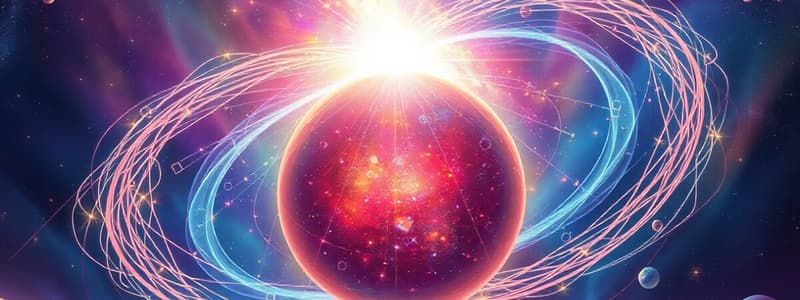Podcast
Questions and Answers
What happens to the viscosity of a liquid when its temperature increases?
What happens to the viscosity of a liquid when its temperature increases?
- Viscosity decreases because particles move faster and farther apart. (correct)
- Viscosity increases due to greater particle attraction.
- Viscosity stays the same regardless of temperature changes.
- Viscosity fluctuates randomly without a clear trend.
Which of the following substances is likely to have a high viscosity?
Which of the following substances is likely to have a high viscosity?
- Water
- Skim milk
- Motor oil
- Honey (correct)
Which factor does NOT affect the viscosity of a liquid?
Which factor does NOT affect the viscosity of a liquid?
- Concentration of particles
- Color of the liquid (correct)
- Strength of particle attraction
- Temperature of the liquid
What is the primary effect of increasing the concentration of particles in a liquid?
What is the primary effect of increasing the concentration of particles in a liquid?
What is the correct formula for calculating flow rate?
What is the correct formula for calculating flow rate?
What is the primary factor that determines the viscosity of a liquid?
What is the primary factor that determines the viscosity of a liquid?
Which of the following changes occurs when a solid is heated and becomes a liquid?
Which of the following changes occurs when a solid is heated and becomes a liquid?
What happens to the particles in a substance as they gain energy?
What happens to the particles in a substance as they gain energy?
Which state of matter has a definite shape and volume?
Which state of matter has a definite shape and volume?
What is the correct term for the change from a gas to a liquid?
What is the correct term for the change from a gas to a liquid?
Which of the following statements is true about gases?
Which of the following statements is true about gases?
What occurs during deposition?
What occurs during deposition?
Which of the following correctly describes particle movement in liquids?
Which of the following correctly describes particle movement in liquids?
Flashcards
Fluid
Fluid
Anything that flows, including liquids and gases.
Viscosity
Viscosity
A measure of a liquid's resistance to flow. It describes how 'thick' or 'thin' a liquid is.
Evaporation
Evaporation
The change of state from a liquid to a gas.
Condensation
Condensation
Signup and view all the flashcards
Melting
Melting
Signup and view all the flashcards
Solidification
Solidification
Signup and view all the flashcards
Sublimation
Sublimation
Signup and view all the flashcards
Deposition
Deposition
Signup and view all the flashcards
Flow Rate
Flow Rate
Signup and view all the flashcards
Viscosity and Flow Rate Relationship
Viscosity and Flow Rate Relationship
Signup and view all the flashcards
Temperature's Impact on Viscosity
Temperature's Impact on Viscosity
Signup and view all the flashcards
Concentration's Impact on Viscosity
Concentration's Impact on Viscosity
Signup and view all the flashcards
Study Notes
States of Matter
-
Fluid: Anything that flows (liquid or gas). Examples include water, syrup, and compressed air.
-
Solids: Have a definite shape and volume. Particles are close together and vibrate in place.
-
Liquids: Have an indefinite shape but a definite volume. Particles are close together but can flow.
-
Gases: Have an indefinite shape and volume. Particles are distant and move randomly.
Changes of State
- Evaporation: Liquid to gas.
- Condensation: Gas to liquid.
- Melting: Solid to liquid.
- Solidification: Liquid to solid.
- Sublimation: Solid to gas.
- Deposition: Gas to solid.
Particle Theory of Matter
- All matter is made of tiny particles.
- Particles in a pure substance are identical. Different substances have different particles.
- There is space between particles.
- Particles are always moving. Their speed increases as they gain energy.
- Particles attract each other. The strength of attraction depends on the type of particle.
Viscosity
- Viscosity is a liquid's resistance to flow (thickness or thinness).
- Greater friction between particles means higher viscosity.
- Flow rate is the time it takes a fluid to flow from one point to another (distance/time).
Factors Affecting Viscosity
- Temperature: Higher temperature reduces viscosity as particles move faster and farther apart.
- Concentration: Increased concentration leads to higher viscosity as there are more particles in a given space.
- Strength of attraction: Stronger attractions between particles lead to higher viscosity.
Studying That Suits You
Use AI to generate personalized quizzes and flashcards to suit your learning preferences.




